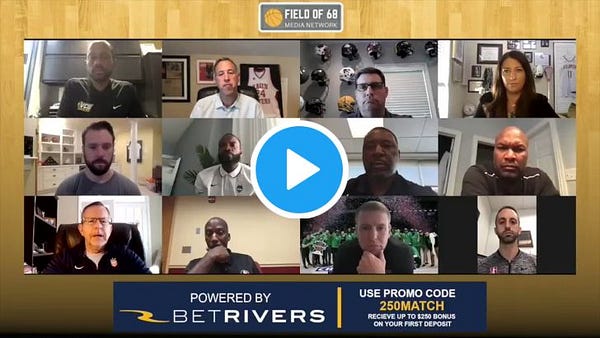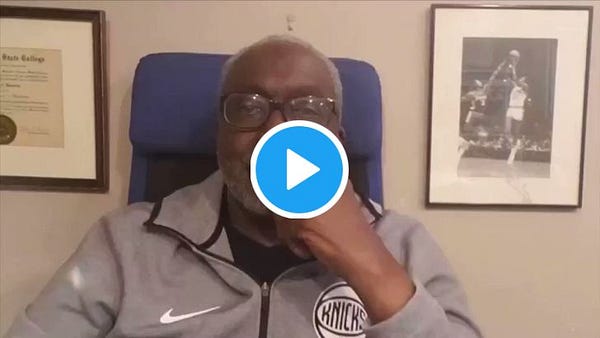Mid-Major Monday: Respect for the HBCU is Long Overdue
College basketball journalist Rob Dauster co-hosted a recent Zoom roundtable, in which conversation turned to the topic of HBCU coaches rarely being considered candidates for other positions. Some of the panelists not-so-subtly put the onus on these coaches.


A few of the more noteworthy comments:
at 1:30 - “There’s got to be a little a hustle, a little self-promotion, a little marketing done, right? And the guys in the HBCU…they’re not out there kind of putting their name[s] out there.
at 2:00 - “Unfortunately, guys, it’s not good enough just to be good at your job anymore.
at 2:28 - “We’re not like fans, we don’t just Google, ‘Hey, who’s No. 1 in your conference? OK, put that person up for a job.’”
at 3:07 - “They need to be out there. Why isn’t anyone on this Zoom?”
That last comment in particular, from one of the representatives of Turnkey Search Firm, seemed especially interesting — if not unintentionally telling. One of the most successful HBCU coaches in the nation, Norfolk State’s Robert Jones, tweeted in response:

If you are in the college basketball space and don’t know of a coach whose resume includes being the top assistant on one of the few No. 15 seeds ever to upset a No. 2 — as Jones was when Norfolk State topped Missouri in 2012 — as well as knocking off an NIT No. 1 seed on the road, which the Spartans accomplished just two years ago; and who coached a team to the NCAA Tournament just this year, you are not doing your job.
And yet, the attitude demonstrated above speaks to a larger cycle that HBCU athletic departments, not just coaches, routinely face. First is a matter of exposure.
HBCU basketball has edged into the national spotlight recently, with Virginia Union alum Ben Wallace selected to the Basketball Hall of Fame. The Detroit Pistons defensive dynamo joins fellow HBCU products-turned-NBA stars in the Hall like New York Knicks legends Willis Reed (Grambling) and Earl Monroe (Winston-Salem State), the latter of whom made a splash this spring joining Twitter.
Boston Celtics star Sam Jones is another HBCU alum in the Hall, having played at North Carolina Central — a program Chris Paul showed love after the Phoenix Suns completed their sweep of the Denver Nuggets.
Paul, who enrolled at Winston-Sale State in the fall to complete his degree, has worn HBCU-themed game shoes and pre/postgame clothes for a few years as part of his efforts to support the schools. SLAM conducted a Q&A with Paul last summer that’s well worth your time.
It’s progress, but the HBCUs have a long way to garner more attention. In general, college basketball media does a poor job covering programs outside of a handful of the highly visible like Kentucky and Duke. Blame lies less with journalists specifically than with a decades-long push from the top to focus more on potential NBA lottery picks than anything else.
Regardless the reasoning, reality is it’s tough gaining eyeballs in an already limited ecosystem. Double that with HBCUs historic disadvantages in that regard: The schools have always been in the background to an extent, the byproduct of segregation in the formative years of sports as cultural phenomenon.
When compiling my All-1940s Team, for example, the standout HBCU players of the time were not afforded opportunities to play in the burgeoning NCAA Tournament or the high-profile NIT. By the 1960s, integrated national champions from Loyola and Texas Western were noteworthy in part for their controversial matchups with segregated SEC opponents.
Forget about the prospects of someone like Adolph Rupp scheduling a game against a great HBCU opponent.
HBCU programs were not on the same stage in the years that blue-blood programs, even those that integrated in the first half of the 20th Century, were gaining national attention.
As for the stories of HBCU’s yesteryear being told today on a larger platform, there’s a twofold challenge. One is how little time and attention is given to history in modern coverage, leaving an unfortunate void.
Another is that the premier platform in basketball belongs to the NCAA Tournament, which hasn’t been so favorable to HBCU participants in recent years.
Remember this past March and the spotlight shined on Oral Roberts. For better or worse, the school’s history was front-and-center amid its improbable run as a No. 15 seed.
Nine No. 15s all-time have upset No. 2s; programs from the all-HBCU MEAC, including the 2012 Norfolk State on which Jones was a staffer, account for one-third of those wins.
But both the MEAC and SWAC have typically been to relegated to the Tournament’s First Four in the past decade, including this past year. Both Norfolk State and Texas Southern won First Four games, tasked with ushering March Madness back into America’s life after a two-year layoff.
“It was going to put a spotlight on our program, and I thought it was important that our kids perform the right way for our program that we feel like we certainly have some tradition in, and for our conference,” Texas Southern coach Johnny Jones said in his First Four postgame Zoom call. “We've got a really good conference that's extremely strong. We've got really good teams and coaches in there, so I'm hopeful that we've played well enough that people will look and see the style and the pace in which we play and they can appreciate our team, our program and then the SWAC.”
The opportunity to play at least two Tournament games can double the exposure (and perhaps more importantly, the paycheck; more on that in a bit). But it’s a double-edged sword.
MEAC teams in the last two Tournaments have been on both sides of the First Four quandary. Norfolk State won a thriller over Appalachian State in 2021, but North Carolina Central dropped a heartbreaker to North Dakota State in 2019 that denied the Eagles a matchup with Duke.
The selection committee failing to pair the two Durham-based universities without the roadblock of a First Four game was a huge whiff on what makes March Madness special. 2019 marked the 75th anniversary of The Secret Game, which you can read more about here.
As for MEAC and SWAC receiving more favorable bids in the Tournament, that plays into the difficult cycle from which HBCUs are expected to escape.
Budget concerns force many of the MEAC and SWAC members to play especially difficult schedules, taking on a bevy of so-called paycheck games. Mississippi Valley State went on a 14-game, 13-state odyssey in the 2015-16 season.
The Houston Chronicle just today published a new edition in its series on HBCU funding focusing on Texas Southern, which has routinely played a top 25 non-conference schedule in the past half-decade.
Not every HBCU financial situation is approaching as dire as that of Grambling athletics eight years ago, when the facilities had become so dilapidated that the football program Eddie Robinson had built into a powerhouse faced a player boycott. Louisiana was in the throes of a particularly brutal assault on public education from then-Gov. Bobby Jindal, and the state’s HBCUs in particular felt the pinch.
But budgetary challenges are of concern for many in the HBCU conferences, and that creates a cycle.
While the above-referenced Zoom panel puts the onus on the coaches themselves to “put themselves out there,” the messengers of the game need to do more to boost HBCU visibility.
This past season in the MEAC featured the emergence of Morgan State as one of the forerunners in uptempo offense, at a time when basketball fans are craving more points in the college game. Norfolk State and NCCU feature two of the most engaging personalities in the coaching ranks between Jones and LeVelle Moton.
Another MEAC coach, Juan Dixon, is one of the greatest college players of all-time and has brought his energy to Coppin State — the first HBCU ever to score a 15-over-2 NCAA Tournament upset. And one of Dixon’s pupils this past season, Anthony Tarke, is someone I believe could find his way onto an NBA roster with his combination of explosiveness on the perimeter and aggressive defense reminiscent of Dixon himself.
The HBCUs have and continue to contribute so much to the game. It’s time the game pays more attention.







